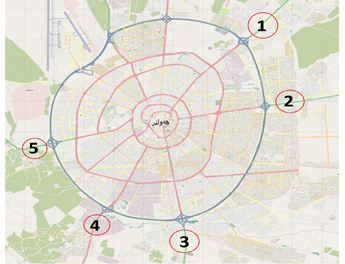Vehicle Traffic Volume and Origin Destination Characteristics for Erbil Rural Highways
DOI:
https://doi.org/10.21271/ZJPAS.35.5.2Keywords:
Vehicle Traffic volume, Traffic Volume, Traffic Characteristics, Origen- DestinationAbstract
The economic growth of Kurdistan region-Iraq is influenced by the traffic flowing expressed in vehicles miles traveled (VMT) because, they are correlated. To get smooth traffic, it is important to know the traffic volume characteristics and the origin – destination pattern. The vehicle traffic volume and the origin destination data at rural area near the outside 120-m ring road at a distance of about 400 m from the proposed interchanges (under construction) with the five main radial roads Kirkuk, Koya, Shaqlawa, Mosul, and Makhmur in Erbil city-Kurdistan region-Iraq is investigated. The classified vehicle volume count, and the origin-destination data on these five locations is collected. Vehicle traffic volume data is collected using video recording technique to determine the number, type and percentages of passenger cars, buses, trucks and other components of the traffic stream for the selected locations. The highest daily traffic volume is on Erbil – Koya highway (49175 vehicles for 24 hours) where, the percentage of heavy vehicles is about 14% and pickups about 21%. The origin - destination study is conducted through a curb-side survey for drivers and the data is collected directly by interview method. The origin-destination study is conducted to know and evaluate the trip characteristics of the traffic and to create the origin - destination matrix (O-D matrix). This matrix is then used to estimate the turning movements at the proposed interchanges. The vehicle occupancy, the purpose of trip and the trip frequency also were investigated. The vehicle occupancy rate is < 2.8 due to the road user’s behavior. A projection is made for the future traffic operations which accounts for the diverted traffic, the generated traffic, the progress traffic, and the normal growth of traffic. The hourly expansion factors (HEF) are between 1.288 and 1.295 depending on the location. The p-factor is also determind and its values ranges between 3.59 and 7.15.
References
Al-Neami, A.H.K. EVENT- A computer program for abstraction of traffic data. Engineering Journal, University of Tikrit, 3(2). (2000).
Arash Moradkhani Roshandeh, Mahmood Mahmoodi Nesheli, and Othman Che Puan, “Evaluation of Traffic Characteristics: A Case Study”, International Journal of Recent Trends in Engineering, Vol. 1, No. 6, May 2009
Beilei Xu; Peter Paul; Yusuf Artan; Florent Perronnin, “machine learning approach to vehicle occupancy detection”, 17th International IEEE Conference on Intelligent Transportation Systems (ITSC), 2014
Catling, I., “A Time-Dependent Approach to Junction Delays” traffic Engineering and Controls, Nov. 1977
David Martin, Chirstopher Gale, Samantha Cockings, and Andrew Harfoot “Origin-destination geodemographics for analysis of travel to work flows”, computers-environment-and-urban-systems, volume 67, January 2018, Pages 68-79
Franco Basso, Raúl Pezoa, Nicolás Tapia and Mauricio Varas, “Estimation of the Origin-Destination Matrix for Trucks That Use Highways: A Case Study in Chile”, Sustainabilit, 14, 2645, 2022.
Noor Moutaz Asmael and Zainab A. Wazer “Prediction Origin-Destination Matrix of Freight Travel Demand in Baghdad City”, Transport Problems, Volume 17, Issue 3, 2022.
N.J. Garber, and L.A. Hoel, Traffic and highway engineering., Cengage Learning: Toronto, 2009
NRA. (2012). “NRA project appraisal guidelines unit 16.2: expansion factors for short-period traffic counts”. Dublin, UK: National Roads Authority.
Reilly R. and Gardner C. “Technique for measuring delay at instructions” Transportation Research Record, 644, 1977, pp. 1-7.
Yong Yuan, Kaigui Bian and Kunqing Xie, “Vulnerability analysis of highway traffic networks using origin-destination tollgate data”, IEEE 19th International Conference on Intelligent Transportation Systems (ITSC), 2016.

Downloads
Published
How to Cite
Issue
Section
License
Copyright (c) 2023 Abdulhakim O. Salih, Aso Faiz Saeed Talabany

This work is licensed under a Creative Commons Attribution 4.0 International License.













